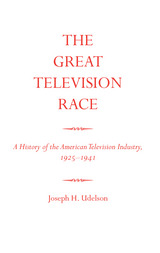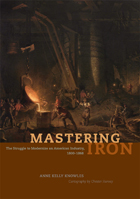2 books about American Industry

The Great Television Race
A History of the American Television Industry, 1925-1941
Joseph H. Udelson
University of Alabama Press, 1989
Television was first successfully demonstrated in 1925; and in 1941 the Federal Communications Commission authorized commercial telecasting in the United States. During the intervening sixteen years the technology of television had been revolutionized, and there had been created an integrated television system. These developments were accomplished amid intense engineering and corporate rivalries of international scope. The result of this competition was the formation of the American television industry composed of three distinct systems: the engineering, the programming, and the promotional. The industry had already reached maturity by the eve of the Second World War, and only the world-wide wartime disruptions prevented its immediate marketing.
The author has utilized a broad range of original sources in order to trace the American television industry from its inception until its commercialization. He demonstrates that the present monochromatic television standards, programming potentials, networking requirements, commercial promotion, and audience research have been the results of incremental achievements accomplished prior to America’s entry into World War II. He analyzes the engineering processes and describes the corporate jockeying for position in the infant industry; and he demonstrates the prominent role played by the federal government in the history of the entire enterprise.
[more]

Mastering Iron
The Struggle to Modernize an American Industry, 1800-1868
Anne Kelly Knowles
University of Chicago Press, 2012
Veins of iron run deep in the history of America. Iron making began almost as soon as European settlement, with the establishment of the first ironworks in colonial Massachusetts. Yet it was Great Britain that became the Atlantic world’s dominant low-cost, high-volume producer of iron, a position it retained throughout the nineteenth century. It was not until after the Civil War that American iron producers began to match the scale and efficiency of the British iron industry.
In Mastering Iron, Anne Kelly Knowles argues that the prolonged development of the US iron industry was largely due to geographical problems the British did not face. Pairing exhaustive manuscript research with analysis of a detailed geospatial database that she built of the industry, Knowles reconstructs the American iron industry in unprecedented depth, from locating hundreds of iron companies in their social and environmental contexts to explaining workplace culture and social relations between workers and managers. She demonstrates how ironworks in Alabama, Maryland, Pennsylvania, and Virginia struggled to replicate British technologies but, in the attempt, brought about changes in the American industry that set the stage for the subsequent age of steel.
Richly illustrated with dozens of original maps and period art work, all in full color, Mastering Iron sheds new light on American ambitions and highlights the challenges a young nation faced as it grappled with its geographic conditions.
[more]
READERS
Browse our collection.
PUBLISHERS
See BiblioVault's publisher services.
STUDENT SERVICES
Files for college accessibility offices.
UChicago Accessibility Resources
home | accessibility | search | about | contact us
BiblioVault ® 2001 - 2024
The University of Chicago Press









